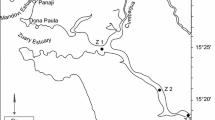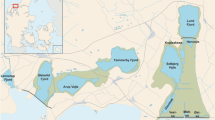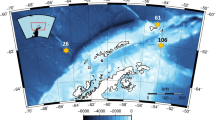Abstract
In situ grazing rates of mixed assemblages of deep-sea benthic boundary-layer zooplankton were measured in July 1983 at a site in the North Atlantic Ocean at 2 175 m depth using a short-term radioisotope-uptake method. Zooplankton were collected with an opening-closing net system from the bottom 1 m of the ocean and incubated in situ with mixed tritiated amino acids in special cod-end chambers. Incubations were terminated at depth by the addition of MS-222. Radioisotope uptake beyond that of dead controls was shown by both the zooplankton and particulate fractions. Grazing rates in the deep-sea experiments were surprisingly high, being comparable to wintertime Narragansett Bay zooplankton grazing rates determined in a separate series of laboratory experiments. These laboratory experiments also documented nonparticle-associated uptake of dissolved amino acids by Narragansett Bay zooplankton, but the importance of this in the deep sea is unknown. The deep-sea benthic boundary layer may be a region of elevated rates and activity because of its higher particulate concentrations, and our experiments may also have measured maximum rather than average rates.
Similar content being viewed by others
Literature cited
Anderson, J. W. and G. C. Stephens: Uptake of organic material by aquatic invertebrates. VI. Role of epiflora in apparent uptake of glycine by marine crustaceans. Mar. Biol. 4, 243–249 (1969)
Baker, E. T. and R. A. Feely: Chemistry of oceanic particulate matter and sediments: implications for bottom sediment resuspension. Science, N.Y. 200, 533–535 (1978)
Bell, C. R. and L. J. Albright: Attached and free-floating bacteria in the Fraser River Estuary, British Columbia, Canada. Mar. Ecol. Prog. Ser. 6, 317–327 (1981)
Biscaye, P. E. and S. L. Eittreim: Suspended particulate loads and transports in the nepheloid layer of the abyssal Atlantic Ocean. Mar. Geol. 23, 155–172 (1977)
Boak, A. C. and R. Goulder: Bacterioplankton in the diet of the calanoid copepod Eurytemora sp. in the Humber Estuary. Mar. Biol. 73, 139–149 (1983)
Bradford, J.: New genera and species of benthic calanoid copepods, from the New Zealand slope. N.Z. Jl mar. Freshwat. Res. 3, 473–505 (1969)
Childress, J. J.: The respiratory rates of midwater crustaceans as a function of depth of occurrence and relation to the oxygen minimum layer off Southern California. Comp. Biochem. Physiol. 50A, 787–799 (1975)
Conover, R. J.: Nutritional strategies for feeding on small suspended particles. In: Analysis of marine ecosystems, pp 363–395. Ed. by A. R. Longhurst. New York: Academic Press 1981
Conover, R. J. and V. Francis: The use of radioactive isotopes to measure the transfer of materials in aquatic food chains. Mar. Biol. 18, 272–283 (1973)
Daro, M. H.: A simplified 14C method for grazing measurements on natural planktonic populations. Helgoländer wiss. Meeresunters. 31, 241–248 (1978)
Deason, E. E.: Grazing of Acartia hudsonica (A. clausi) on Skeletonema costatum in Narragansett Bay (USA): influence of food concentration and temperature. Mar. Biol. 60, 101–113 (1980)
Deming, J. W., P. S. Tabor and R. R. Colwell: Barophilic growth of bacteria from intestinal tracts of deep-sea invertebrates. Microb. Ecol. 7, 85–94 (1981)
Eidreim, S., E. M. Thorndike and L. Sullivan: Turbidity distribution in the Atlantic Ocean. Deep-Sea Res. 23, 1115–1127 (1976)
Fellows, D. A., D. M. Karl and G. A. Knauer: Large particle fluxes and the vertical transport of living carbon in the upper 1 500 meters of the northeast Pacific Ocean. Deep-Sea Res. 23 A, 921–936 (1981)
Ferguson, J. C.: A comparative study of the net metabolic benefits derived from the uptake and release of free amino acids by marine invertebrates. Biol. Bull. mar. biol. Lab., Woods Hole 162, 1–17 (1982)
Fahrman, J. A. and F. Azam: Thymidine incorporation as a measure of heterotrophic bacterioplankton production in marine surface waters: evaluation and field results. Mar. Biol. 66, 109–120 (1982)
Fuzessery, Z. M. and J. J. Childress: Comparative chemosensitivity to amino acids and their role in the feeding activity of bathypelagic and littoral crustaceans. Biol. Bull. mar. biol. Lab., Woods Hole 149, 522–538 (1975)
Gamble, J. C.: Copepod grazing during a declining spring phytoplankton bloom in the northern North Sea. Mar. Biol. 49, 303–315 (1978)
Gordon, D. C.: Some studies on the distribution and composition of particulate organic carbon in the North Atlantic Ocean. Deep Sea Res. 17, 233–243 (1970)
Grice, G. D.: The existence of a bottom-living calanoid copepod fauna in deep water with descriptions of five new species. Crustaceana 23, 219–242 (1972)
Grice, G. D. and K. Hulsemann: New species of bottom-living calanoid copepods collected in deep water by the DSRV ALVIN. Bull. Mus. comp. Zool. Harv. 139, 185–227 (1970)
Hand, S. C. and G. N. Somero: Energy metabolism pathways of hydrothermal vent animals: adaptations to a food-rich and sulfide-rich deep-sea environment. Biol. Bull. mar. biol. Lab., Woods Hole 165, 167–181 (1983)
Haney, J. F.: An in situ method for the measurement of zooplankton grazing rates. Limnol. Oceanogr. 16, 970–977 (1971)
Hiller-Adams, P. and J. J. Childress: Effects of feeding, feeding history; and food deprivation on respiration and excretion rates of the bathypelagic mysid Gnathophausia ingens. Biol. Bull. mar. biol. Lab., Woods Hole 165, 182–196 (1983)
Hodson, R. E., A. E. Maccubbin and L. R. Pomeroy: Dissolved adenosine triphosphate utilization by free-living and attached bacterioplankton. Mar. Biol. 64, 43–51 (1981)
Honjo, S.: Sedimentation of materials in the Sargasso Sea at a 5,367 m deep station. J. mar. Res. 36, 469–492 (1978)
Huntley, M.: Nonselective, saturated feeding by three calanid copepod species in the Labrador Sea. Limnol. Oceanogr. 26, 831–842 (1981)
Jannasch, H. W. and C. O. Wirsen: Deep-sea microorganisms: in situ response to nutrient enrichment. Science, N.Y. 180, 641–643 (1973)
Jannasch, H. W. and C. O. Wirsen: Microbial activities in undecompressed and decompressed deep-seawater samples. Appl. envirl Microbiol. 43, 1116–1124 (1982)
Jannasch, H. W. and C. O. Wirsen: Microbiology of the deep sea. In: Deep-sea biology, pp 231–259. Ed. by G. T. Rowe. New York: John Wiley 1983
Karl, D. M. and G. A. Knauer: Vertical distribution, transport, and exchange of carbon in the northeast Pacific Ocean. evidence for multiple zones of biological activity. Deep-Sea Res. 31, 221–243 (1984)
Karl, D. M., P. A. LaRock, J. W. Morse and W. Sturges: Adenosine triphosphate in the North Atlantic Ocean and its relationship to the oxygen minimum. Deep-Sea Res. 23, 81–88 (1976)
Karl, D. M., C. O. Wirsen and H. W. Jannasch: Deep-sea primary production at the Galapagos hydrothermal vents. Science, N.Y. 207, 1345–1347 (1980)
Kirchman, D. and R. Mitchell: Contribution of particle-bound bacteria to total microheterotrophic activity in five ponds and two marshes. Appl. envirl Microbiol. 43, 200–209 (1982)
Lampert, W.: Studies on the carbon balance of Daphnia pulex as related to environmental conditions. I. Methodological problems of the use of 14C for the measurement of carbon assimilation. Arch. Hydrobiol. (Suppl.) 48, 287–309 (1977)
Marshall, S.: Respiration and feeding in copepods. Adv. mar. Biol. 11, 57–120 (1973)
McCave, I. N.: Particulate size, behavior, and origin of nepheloid layers over the Nova Scotian continental rise. J. geophys. Res. 88, 7647–7666 (1983)
Montagna, P. A.: Live controls for radioisotope tracer food chain experiments using meiofauna. Mar. Ecol. Prog. Ser. 12, 43–46 (1983)
Peters, R. H. and J. A. Downing: Empirical analysis of zooplankton filtering and feeding rates. Limnol. Oceanogr. 29, 763–784 (1984)
Poulet, S. A.: Seasonal grazing of Pseudocalanus minutus on particles. Mar. Biol. 25, 109–123 (1974)
Poulet, S. A. and G. Ouellet: The role of amino acids in the chemosensory swarming and feeding of marine copepods. J. Plankton Res. 4, 341–361 (1982)
Rhoads, D. C., R. A. Lutz, F. C. Revelas and R. M. Cerrato: Growth of bivalves at deep-sea hydrothermal vents along the Galapagos Rift. Science, N.Y. 214, 911–913 (1981)
Roman, M. R. and P. A. Rublee: A method to determine in situ zooplankton grazing rates on natural particle assemblages. Mar. Biol. 65, 303–309 (1981)
Rowe, G. T. and W. D. Gardner: Sedimentation rates in the slope water of the northwest Atlantic Ocean measured directly with sediment traps. J. mar. Res. 37, 581–600 (1979)
Schwarz, J. R. and R. R. Colwell: Heterotrophic activity of deep-sea sediment bacteria. Appl. envirl Microbiol. 30, 639–649 (1975)
Schwarz, J. R., A. A. Yayanos and R. R. Colwell: Metabolic activities of the intestinal microflora of a deep-sea invertebrate. Appl. envirl Microbiol. 31, 46–48 (1976)
Smith, K. L., Jr.: Zooplankton of a bathyal benthic boundary layer: in situ rates of oxygen consumption and ammonium excretion. Limnol. Oceanogr. 27, 461–471 (1982)
Smith, K. L., Jr.: Metabolism of two dominant epibenthic echinoderms measured at bathyal depths in the Santa Catalina Basin. Mar. Biol. 72, 249–256 (1983)
Smith, K. L., Jr. and R. J. Baldwin: Scavenging deep-sea amphipods: effects of food odor on oxygen consumption and a proposed metabolic strategy. Mar. Biol. 68, 287–298 (1982)
Smith, K. L., Jr. and R. J. Baldwin: Seasonal fluctuations in deep-sea sediment community oxygen consumption: central and eastern North Pacific. Nature. Lond. 307, 624–625 (1984)
Smith, K. L. and R. R. Hessler: Respiration of benthopelagic fishes: in situ measurements at 1 230 meters. Science, N.Y. 184, 72–73 (1974)
Smith, K. L., Jr. and K. R. Hinga: Sediment community respiration in the deep sea. In: Deep-sea biology, pp 331–370. Ed. by G. T. Rowe. New York: John Wiley 1983
Spencer, D. W., P. G. Brewer, A. Fleer, S. Honjo, S. Krishnaswami and Y. Nozaki: Chemical fluxes from a sediment trap experiment in the deep Sargasso Sea. J. mar. Res. 36, 493–523 (1978)
Stephens, G. C. and R. A. Schinske: Uptake of amino acids by marine invertebrates. Limnol. Oceanogr. 6, 175–181 (1961)
Stewart, M. G.: Absorption of dissolved organic nutrients by marine invertebrates. Oceanogr. mar. Biol. A. Rev. 17, 163–192 (1979)
Tate, M. W. and R. C. Clelland: Nonparametric and shortcut statistics, 171 pp. Danville: Interstate Printers 1957
Torres, J. J., B. W. Belman and J. J. Childress: Oxygen consumption rates of midwater fishes as a function of depth of occurrence. Deep-Sea Res. 26A, 185–197 (1979)
Turekian, K. K. and J. K. Cochran: Growth rate of a vesicomyid clam from the Galapagos Spreading Center. Science, N.Y. 214, 909–911 (1981)
Turekian, K., J. Cochran, D. Kharkar, R. Cerrato, J. R. Vaisnys, H. Sanders, J. F. Grassle and J. Allen: Slow growth rate of a deep-sea clam determined by 228Ra chronology. Proc. natn. Acad. Sci. U.S.A. 72, 2829–2832 (1975)
Wishner, K. F.: The biomass of the deep-sea benthopelagic plankton. Deep-Sea Res. 27 A, 203–216 (1980a)
Wishner, K. F.: Aspects of the community ecology of deep-sea benthopelagic plankton, with special attention to gymnopleid copepods. Mar. Biol. 60, 179–187 (1980b)
Wishner, K. F. and C. J. Meise-Munns: MS-222: A useful in situ killing agent when container re-use is necessary. (In preparation). (1984)
Yayanos, A. A., A. S. Dietz and R. V. Boxtel: Isolation of a deep-sea barophilic bacterium and some of its growth characteristics. Science, N.Y. 205, 808–809 (1979)
Author information
Authors and Affiliations
Additional information
Communicated by N. D. Holland, La Jolla
Rights and permissions
About this article
Cite this article
Wishner, K.F., Meise-Munns, C.J. In situ grazing rates of deep-sea benthic boundary-layer zooplankton. Mar. Biol. 84, 65–74 (1984). https://doi.org/10.1007/BF00394528
Accepted:
Issue Date:
DOI: https://doi.org/10.1007/BF00394528




